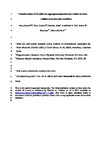Transformation of C60 fullerene aggregates suspended and weathered under realistic environmental conditions
| dc.contributor.author | Sanchís, J | |
| dc.contributor.author | Aminot, Y | |
| dc.contributor.author | Abad, E | |
| dc.contributor.author | Jha, Awadhesh | |
| dc.contributor.author | Readman, JW | |
| dc.contributor.author | Farré, M | |
| dc.date.accessioned | 2017-12-12T14:27:38Z | |
| dc.date.issued | 2018-03 | |
| dc.identifier.issn | 0008-6223 | |
| dc.identifier.issn | 1873-3891 | |
| dc.identifier.uri | http://hdl.handle.net/10026.1/10407 | |
| dc.description.abstract |
The occurrence, fate and behaviour of carbon nanomaterials in the aquatic environment are dominated by their functionalization, association with organic material and aggregation behaviour. In particular, the degradation of fullerene aggregates in the aquatic environment is a primary influence on their mobility, sorption potential and toxicity. However, the degradation and kinetics of water suspensions of fullerenes remain poorly understood. In the present work, first, an analytical method based on liquid chromatography and high-resolution mass spectrometry (LC-HRMS) for the determination of C60 fullerene and their environmental transformation products was developed. Secondly, a series of C60 fullerene water suspensions were degraded under relevant environmental conditions, controlling the salinity, the humic substances content, the pH and the sunlight irradiation. Up to ten transformation products were tentatively identified, including epoxides and dimers with two C60 units linked via one or two adjacent furane-like rings. Fullerenols were not observed under these environmentally relevant conditions. The kinetics of generation of each transformation product were studied with and without simulated sunlight conditions. The ionic strength of the media, its pH and the humic substances content were observed to modulate the kinetics of generation. | |
| dc.format.extent | 54-62 | |
| dc.language | en | |
| dc.language.iso | en | |
| dc.publisher | Elsevier | |
| dc.title | Transformation of C60 fullerene aggregates suspended and weathered under realistic environmental conditions | |
| dc.type | journal-article | |
| dc.type | Journal Article | |
| plymouth.author-url | https://www.webofscience.com/api/gateway?GWVersion=2&SrcApp=PARTNER_APP&SrcAuth=LinksAMR&KeyUT=WOS:000418479900007&DestLinkType=FullRecord&DestApp=ALL_WOS&UsrCustomerID=11bb513d99f797142bcfeffcc58ea008 | |
| plymouth.volume | 128 | |
| plymouth.publication-status | Published | |
| plymouth.journal | Carbon | |
| dc.identifier.doi | 10.1016/j.carbon.2017.11.060 | |
| plymouth.organisational-group | /Plymouth | |
| plymouth.organisational-group | /Plymouth/Admin Group - REF | |
| plymouth.organisational-group | /Plymouth/Admin Group - REF/REF Admin Group - FoSE | |
| plymouth.organisational-group | /Plymouth/Faculty of Science and Engineering | |
| plymouth.organisational-group | /Plymouth/Faculty of Science and Engineering/School of Biological and Marine Sciences | |
| plymouth.organisational-group | /Plymouth/REF 2021 Researchers by UoA | |
| plymouth.organisational-group | /Plymouth/REF 2021 Researchers by UoA/UoA06 Agriculture, Veterinary and Food Science | |
| plymouth.organisational-group | /Plymouth/REF 2021 Researchers by UoA/UoA06 Agriculture, Veterinary and Food Science/UoA06 Agriculture, Veterinary and Food Science MANUAL | |
| plymouth.organisational-group | /Plymouth/Research Groups | |
| plymouth.organisational-group | /Plymouth/Research Groups/Marine Institute | |
| plymouth.organisational-group | /Plymouth/Users by role | |
| plymouth.organisational-group | /Plymouth/Users by role/Academics | |
| plymouth.organisational-group | /Plymouth/Users by role/Researchers in ResearchFish submission | |
| dcterms.dateAccepted | 2017-11-20 | |
| dc.rights.embargodate | 2018-11-24 | |
| dc.identifier.eissn | 1873-3891 | |
| dc.rights.embargoperiod | Not known | |
| rioxxterms.versionofrecord | 10.1016/j.carbon.2017.11.060 | |
| rioxxterms.licenseref.uri | http://www.rioxx.net/licenses/all-rights-reserved | |
| rioxxterms.licenseref.startdate | 2018-03 | |
| rioxxterms.type | Journal Article/Review | |
| plymouth.funder | Elucidating the potential interaction of manufactured nanoparticles with polycyclic aromatic hydrocarbons: An integrated toxicogenomics approach::NERC |


